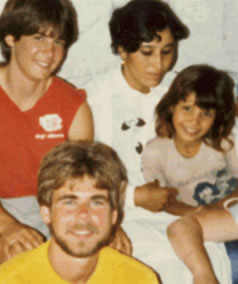 7 February 1983
7 February 1983
Cairo to Luxor by train
Lush green fields with ancient irrigation, palm trees, lots of mud bricks, women washing clothes in the river. Bundles of greens. Camels, water buffalo, donkeys. Rush-bundle houses. Irrigation is called "shaduf."
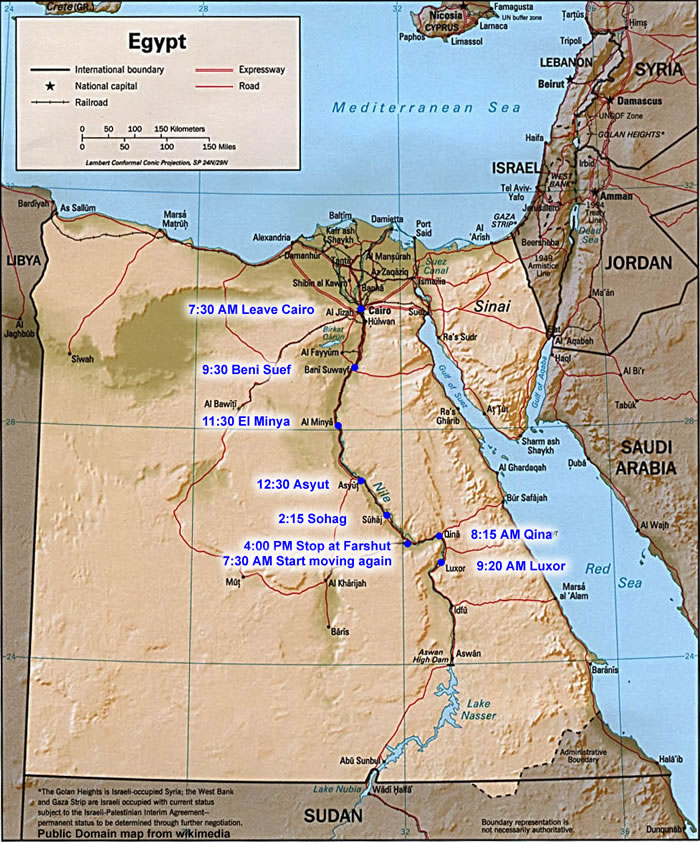
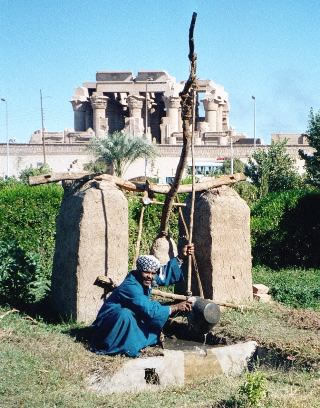
Credit: Hajor, from Wikipedia
7:30 Cairo
9:30 Beni Suef
11:30 El Minya
12:30 Asyut
2:15 Sohag
4:00 PM Stop at Nag Hammadi (Farshut, actually) because of accident at Omkombo.
9:30 PM and I am still stuck at Farshut. I tried to walk around the town, and actually did get through once, but as soon as people see I am American I am instantly mobbed. I think I will buy a galabeyya and something to wrap my head in.
My Arabic is improving rapidly. Made a friend – Yasr, a pilot in the Egyptian army (Mig 17). He wrote in my journal and drew his plane. Told him I would come and visit in the summer, so I’ll have to work on Cheryl.
This morning I had a typical Egyptian breakfast in a very local place. It was pretty grungy - there was even a weasel scurrying around. I had ful, aish, tomatoes, tamaiya (beans, bread, tomotoes and felafel). And it was only 50 p.! (I later learned that was a lot.) Lived off Egyptian hospitality rest of the day.
Started moving again at 12:00 AM, so I went to sleep. When I woke up in the middle of the night we were stopped again. Went out in the morning and read Exodus on a pile of mud bricks.
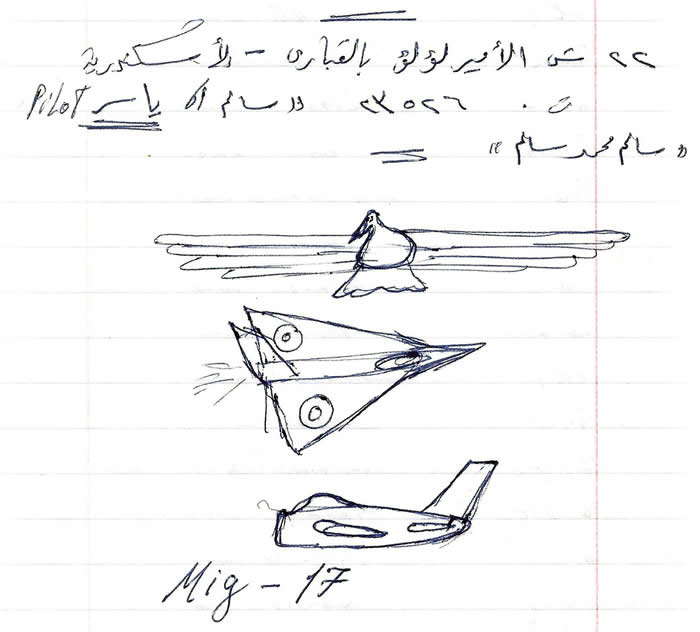 ________________________________________________________________
________________________________________________________________
8 February 1983
7:30 We start moving again.
8:15 Qena
9:20 AM Arrive Luxor
Walked through market area. People sitting crowded along the dirt streets selling ducks, chickens, vegetables, grains, rabbits.
I am reminded I am in the third world.
Met up with the University of California group and sailed down the Nile in a felucca with them.
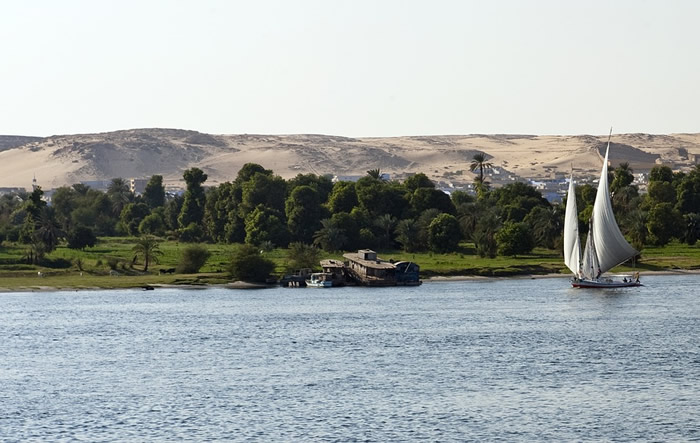
9 February 1983
Valley of the Kings
Donkey to the Valley of the Kings. Started at 10:30 in morning from west bank. Suddenly leave Nile Valley greenness behind and start climbing up the barren, rock-strewn sahara el gherbia mountains. A wild ride, and donkeys are a so fun to ride! Arrive Valley of the Kings at 12:15, explore tombs until 2:30.
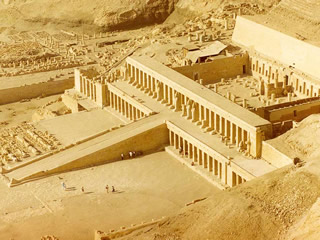
Seti I beautiful plaster relief hieroglyphs and pictures with some beautiful coloration. Many pictures with Seti bringing offerings to each god: Maat, Osiris, Isis, Ra. In sarcophagus chamber…[see Journal]
Ramses VI “grand although artwork in Seti’s attracted me more” [see Journal]
Tutankhamun [see Journal]
Amenophis III This was the one I really liked. Much simpler drawing style – just painted, no reliefs – but this is what attracted me. Perfect preservation draws you in. Beautiful blue sky with stars on roof. Colors are subdued. Enchanting.
Ramses III [see Journal]
We leave, climb up the mountain again with our donkeys, and suddenly come over a ridge where we can see out over the wasteland to the beautiful Nile Valley with its greens and light greens, to the desert on the other side. Came down to Hatshepsut’s temple – three tiered with temple to Hathor on one side, and to Anubis on the other. Pictures chiseled away.Guide took me out back where there was a real mummy! I picked up the head which was bashed in – like paper mache. Still had hair and teeth.
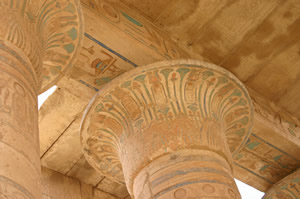 Then came to the “Rammoseum” – magnificent temple with fallen 70ft red marble statue of Ramses. Beautiful columns with lotus heads. I remember looking through the columns to the deep, deep blue sky.
Then came to the “Rammoseum” – magnificent temple with fallen 70ft red marble statue of Ramses. Beautiful columns with lotus heads. I remember looking through the columns to the deep, deep blue sky.
 Whole area of temple is surrounded by mud brick buildings in ruins. And all along western edge area many large arched chambers, say 30 m long, 10 m high, maybe 20 or possibly more of them, like airplane hangars.
They sure look like storehouses to me! Maybe this is similar to what it looked like long ago: “So they put slave masters over them to oppress them with forced labor and they build Pithom and Rameses as store cities for Pharoah” (Exodus 1:11).
Whole area of temple is surrounded by mud brick buildings in ruins. And all along western edge area many large arched chambers, say 30 m long, 10 m high, maybe 20 or possibly more of them, like airplane hangars.
They sure look like storehouses to me! Maybe this is similar to what it looked like long ago: “So they put slave masters over them to oppress them with forced labor and they build Pithom and Rameses as store cities for Pharoah” (Exodus 1:11).
We rode home through the sugar cane fields as the sun was setting. Back on the east bank I watched the sun set over the Nile as boys climbed
preposterously high on the colorful felucca masts to tie the sails.
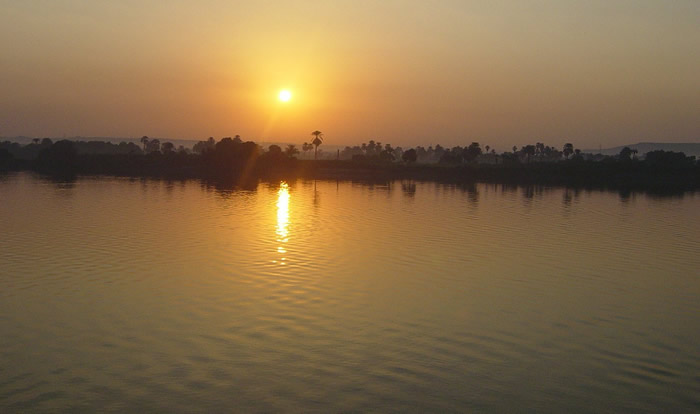 ________________________________________________________________
________________________________________________________________
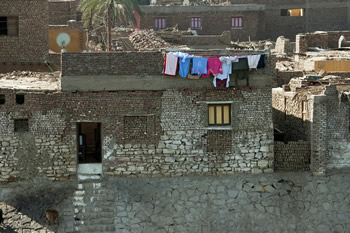
10 February 1983
Life in Luxor
Eating breakfast in my usual place in Luxor – bread, soup, tamiyya, salad – I met a group of teachers from the local grade school. I went back with Sha’aban to his school. All the children were sitting around in this big courtyard of sand. When I came, those who were designated as “soldiers” began acting very official, kicking people to get them to move. The teachers are not any better, though – to move the children they kick them and hit them on the back with a stick. Not hard enough to really hurt, but I find it a little disturbing. There is a different attitude towards authority and hierarchy here. The children were all dressed in dirty white coveralls. At the end of their recess they did their “flag salute” – which consists of rows of children chanting and clapping, while a band plays in the center of the square. It was beautiful to watch them. Then they marched back to class.
After school, Sha’aban drove me on his bicycle over the dirt paths of Luxor to his home, a very poor mud house. We ate typical poor meal: goats cheese with a brown spicy sauce, bread, onions, and a leafy vegetable. Plus a special treat – jam. It was wonderful to spend time with them.
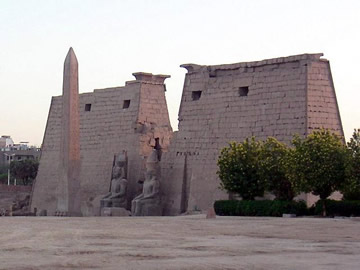
In the evening I visited the Luxor temple. It was beautiful in sunset: giant pink columns against the pale blue sky. Spent 2 ½ hours from 5 to 7:30. Favorite part was the work of Amenophis III, especially great forecourt. The birthroom was also fascinating.
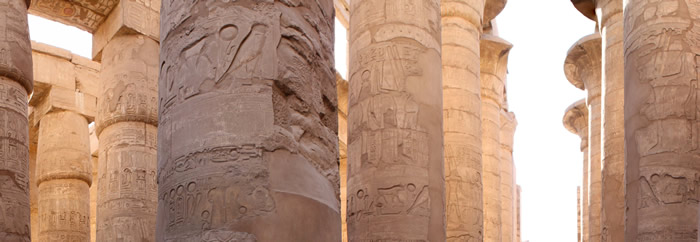 Later, as I wandered the streets, I came upon a memorial service. Bright red quilting and naked white light bulbs hung across a back alley to transform it into a tent – it reminded me of a small circus tent. I sat for an hour and listened to the beautiful chanting of the Qur’an accompanied by devotional dancing. I was told this was the one year memorial service for a Muslim religious leader. Served us Turkish coffee.
________________________________________________________________
Later, as I wandered the streets, I came upon a memorial service. Bright red quilting and naked white light bulbs hung across a back alley to transform it into a tent – it reminded me of a small circus tent. I sat for an hour and listened to the beautiful chanting of the Qur’an accompanied by devotional dancing. I was told this was the one year memorial service for a Muslim religious leader. Served us Turkish coffee.
________________________________________________________________
11 February 1983
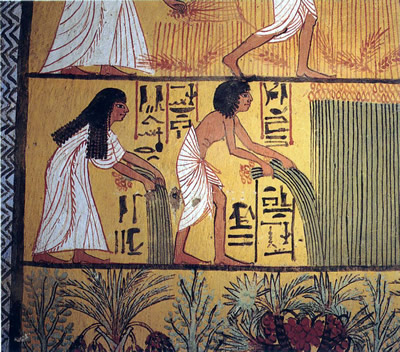
Biking around Thebes
Rented a bicyle and spent the day riding around the west bank of Thebes.
12:00 Deir El Medina. Nobles tombs and temples. Senejeb’s tomb is the most gorgeous of anything I’ve seen. Ordinary people working together, their hair in ringlets. Temple was erected by Amenophis III for his vizier Amenhotep. Tomb of Amenek is also beautiful. These striking tomb paintings are my favorite part of the antiquities.
1:00 Valley of the Queens
Tomb of Amen Khoshef and of Chomsou – both sons of Ramses III. Beautiful colors and images. Not overdone, like Ramses III’s temple in Karnak.
Biked the afternoon along the water paths of Luxor’s green and yellow fields.

Credit: Christian Rosenbaum, from Wikipedia
-----------------------
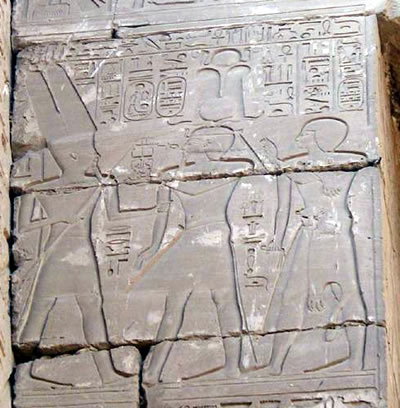
Credit: Neithsabes, from Wikipedia
12 February 1983
Karnak and Aswan
Morning in Karnak, from 10:30 to 1:30. Sheshank is fantastic: these are my fathers, before my eyes…. Sacred pool is also very beautiful. [It is interesting I would see these ancient Hebrews as “my fathers” when my ancestors were actually living far away in the Islands of Ireland and England at this time, and for thousands of years previously.]


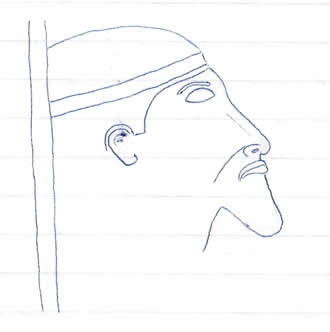
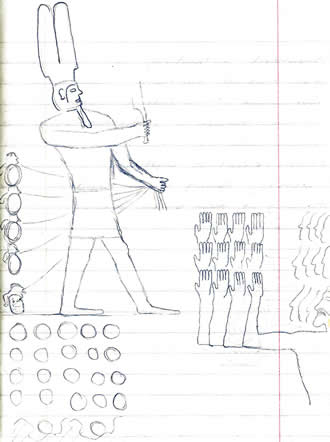
 ______________________________________________________
Sheshank is leading five rows of thirteen
over four rows of seventeen
over at least one more indistinct row.
Of the kneeling captives,
twenty are facing him, and
twenty at their backs, facing away.
______________________________________________________
Sheshank is leading five rows of thirteen
over four rows of seventeen
over at least one more indistinct row.
Of the kneeling captives,
twenty are facing him, and
twenty at their backs, facing away.
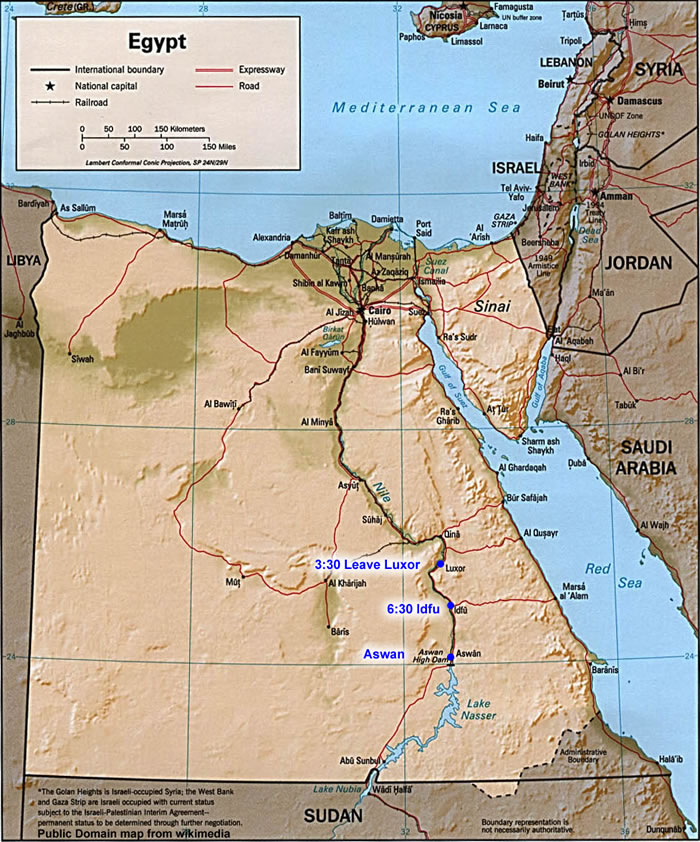 ______________________________________________________
______________________________________________________
Took 3:30 train to Aswan – third class for 30 piastres! Third class is the way to go – you get to sit with regular people, the windows are open, the benches are nice. I sat for an hour in the open doorway and watched the sun set and the sky turn red behind the palms. Nile valley is so distinctive with green on one side, barren desert on the other. At every village we would jump off the train to drink some water in a tiny mud restaurant.

I also recall jumping out at stops to buy sugar cane, or sugar cane juice: asab عصير قصب .

Credit: Food Trails, from Wikimedia
Befriended Miskim, a very warm young man who speaks about as much English as I speak Arabic. So we taught each other a lot. [See all the pages of notes at the end of this journal, listing words in Hebrew and their Arabic transliterations.]
We decided to try to get a cab to Aswan, and we got off at Idfu at 6:30. So I have spent a couple of hours in Idfu. Ended up playing dominoes and drinking halba (made from fenugreek). Although I'm not a smoker, I even took a few puffs of ma9asal معسل (honeyed tobacco) through a water pipe.
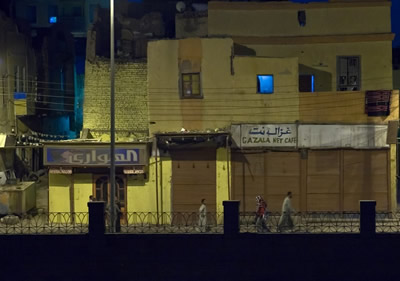
Slept outside by the Nile. [I was a bit nervous sleeping out in such an exposed place, but I just put my bag down in some stone courtyard by the water and tried to go to sleep with prayers for protection. I was in my bag, but my face was exposed, and the mosquitoes kept biting me. I finally wrapped a t-shirt around my face, just to give myself enough relief to fall asleep. When I woke up, the t-shirt had fallen off and I was well-bitten, but at least I had slept.]
13 February 1983
Hanging out with Miskim in Aswan
Spent the day with Miskim, visiting lots of his family, drinking lots of tea and watching T.V. This trip has been wonderful - I have been experiencing the life of the real people.
The common life seems to have a lot of time to kill. Doms. [??] In the evening we went and saw an Arabic movie which I didn’t understand but enjoyed. I especially enjoyed the scene in which they make fun of an American tourist who expects everyone to speak English. And then… Miskim’s strange disappearance!
[What I recall is that Miskim had been asking and asking that I spend the night at his house. I had said no repeatedly – not because I did not want to stay with him, but because I was trying to do the proper cultural thing. And I was just about to finally agree to stay at his house, when I think Miskim must have decided I was shaming his family and disappeared.]
14 February 1983
Aswan
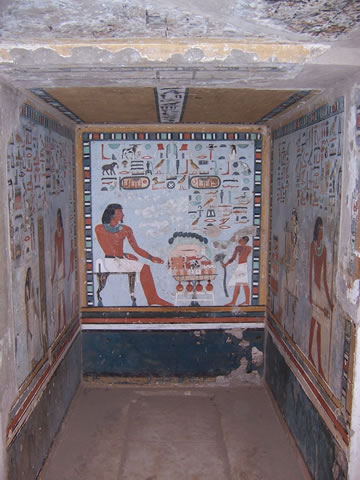 Aswan – Nobles Tombs
1) Bibi Nakht and Hika-ib pictures of servants bringing food as if to feed their masters in the afterlife. Everyday scenes of fishing, of smelling a lotus. Nobleman is pictured, along with his family.
Aswan – Nobles Tombs
1) Bibi Nakht and Hika-ib pictures of servants bringing food as if to feed their masters in the afterlife. Everyday scenes of fishing, of smelling a lotus. Nobleman is pictured, along with his family.
2) Sirimbut I pretty sandstone carvings in entrance
3) Khunas
4) Sirimbut II the nicest: cut well and well-preserved. Entrance chamber with columns, hallway, and inner chamber.
Afternoon
Walk through the streets of Aswan, get taken as I bargain for shirt. I accept my losses and want to learn my lesson: Always shop, and shop well. Shop to learn, not to buy; and never buy the first one you see.
And then, bargain ridiculously - he is!
Train at 3:00 to El Sadd El Aalie (High Dam.) Walked across dam to the eastern side where there is a huge monument - six leaves of concrete, each over 100 meters high, joined by a large ring at the top. [Wikimedia: The lotus monument from the high dam at Aswan, celebrated the building of the dam by Egypt and Russia.]
I met some geological engineers and we talked for several hours. They work at the dam. As9ad really encouraged me, telling me of his desire for peace with Israel and his support of Camp David. Also his love of Jimmy Carter, because he has "good character." He was earnest in his hope. As a college-grad engineer he said that he makes $100 a month (another friend said $45) and said his expenses run between $60-$100 a month.
On this trip I have had the chance to meet local people and learn about something of their lives.
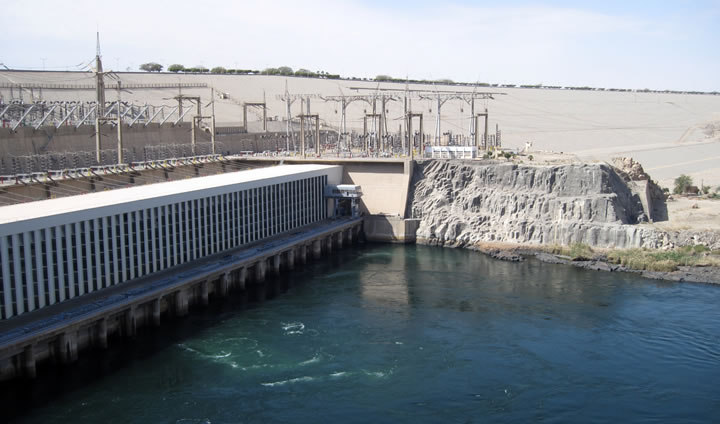
Credit: Olaf Tausch, from Wikimedia
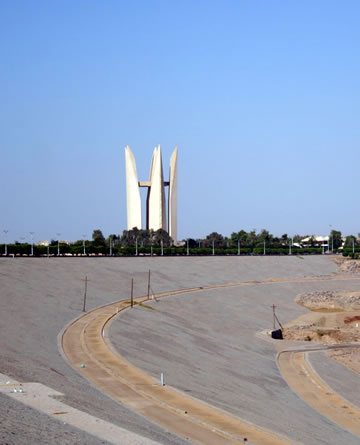
Credit: Steve F-E-Cameron, from Wikimedia
Learning some Arabic has been important for making connections - I need to remember this for future travels.
It was beautiful to sit and talk with these new friends, and watch the red sun set between the giant leaves of the dam.
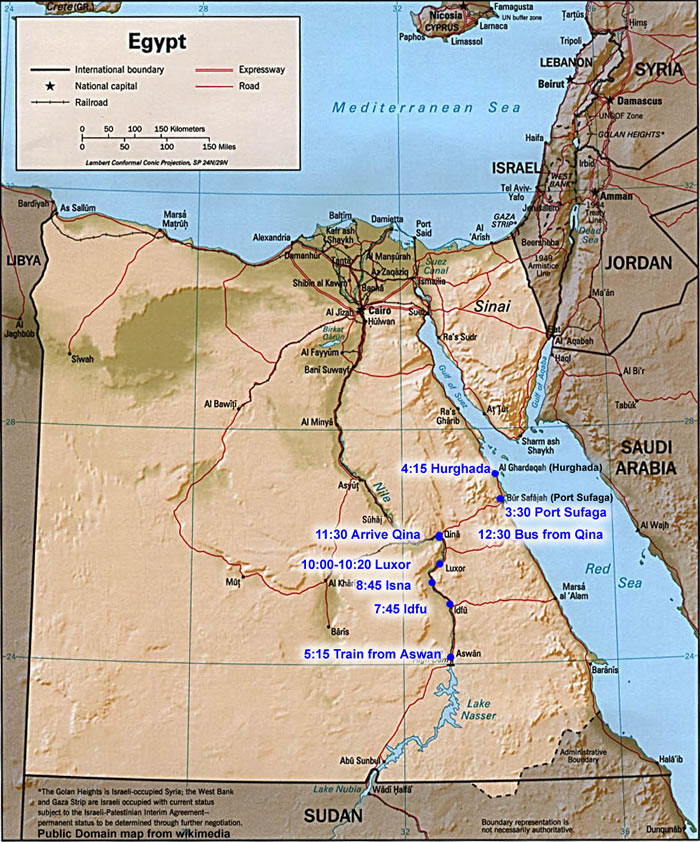
15 February 1983
Train and bus from Aswan to Hurghada
I watched a red sun rise on the 5:15 train to Qina.
7:45 Idfu
8:45 Isna
10:00 to 10:20 Luxor
11:30 Qina
I took the 12:30 bus from Qina across the eastern Sahara. It felt good to get into the desert. Flat and barren, with occasional tables like the Negev. Sand dunes with brown rocks sprinkled along the crests. This desert is very different from the Sinai. The colors here are bland: white sand, brown rocks. Sand, unlike the Negev, Judean and Sinai deserts.

Credit: Anton Lefterov, from Wikimedia
3:30 We break out onto the coast, Port Sufaga, and arrive at Hurghada at 4:15. I take a long walk through the town, and then go to the beach in the evening and say a prayer.
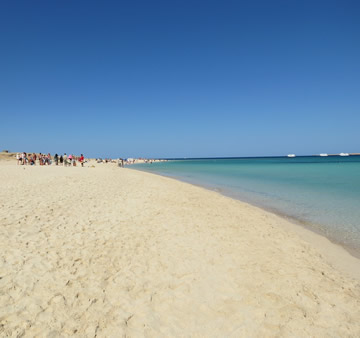
16 February 1983
Hurghada
I walk to the beach, which I expect o be similar to the Sinai. I am shocked to find it covered with tar. Tar for miles. I go snorkeling and see just 2 fish. Most of the coral has been killed. [From the beautiful underwater photos I see online in 2014, and the clean white beach you see in this photo, it looks like they have helped the ecosystem recover. And it appears the town has been developed significantly as a tourist destination, with beautiful hotel pools and a Hard Rock Cafe!]
17 February 1983
Qina
Morning bus back to Qina. I meet John Dunkin and we decide to get a room together. He is an interesting guy. He lived in Libya, and has now lived in Cairo for 2 years teaching English.
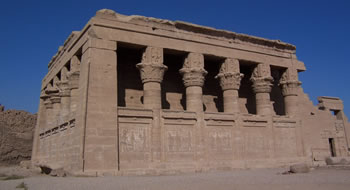
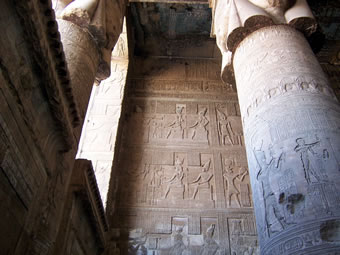 We visited Dandara Temple, which became my favorite. The roof is intact, so when you enter you are actually in a temple.
…
We visited Dandara Temple, which became my favorite. The roof is intact, so when you enter you are actually in a temple.
…
I spent the evening walking through the market, then had dinner with John.
18 February 1983
Qina to Asyut and Mallawi
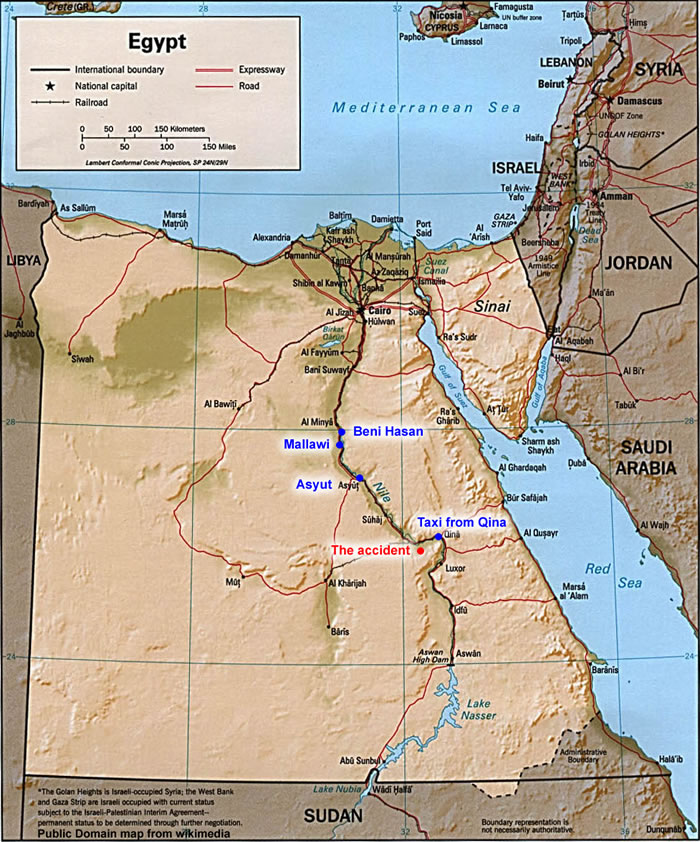 Taxi from Qina to Asyut. 3 pounds and about 3 1/2 hours. Our driver had a really crazed look in his eyes all the time, with his hands and arms locked around the wheel.
Taxi from Qina to Asyut. 3 pounds and about 3 1/2 hours. Our driver had a really crazed look in his eyes all the time, with his hands and arms locked around the wheel.
And then we saw the accident. Two cars smashed, smoke pouring across the road. I saw a man in a striped galabaya….
The Accident
Our taxi was 30 minutes out of Qena when we saw the accident. One car was crumpled, stuffed between some palms; the other was smashed upside down in some sugarcane. Smoke poured across the road from mud-brick ovens, and ghostly galabayas hovered near the cars.
I ran over. Through the smoke I saw a man in a striped galabaya, tossed on the pavement with limbs twisted under, his forehead bleeding.
The ghostly figures stood back, so I pushed through the smoky crowd and knelt down beside the man. His eyes stared up with confusion and fear. I was furious that no one was doing anything, so I stripped off my sweatshirt, balled it up, and placed it under his head. He winced.
I told him, "It will be okay, it will be okay," and inside I thought, He doesn't understand English. He tried to get up, broken limbs flopping on the pavement, but I held him down gently, and told him, "No, no, you can't move – wait for the doctor." He groaned.
Then the businessman who had come with me from Qena took my arm and began to pull me away, saying, "Come on, we must go." I protested as he pulled me, and I saw the bashed man sitting up. "The driver doesn't want to be delayed," said the businessman.
"Besides – no doctor will come. This is not America." As our taxi inched forward I watched the man in the striped galabaya drag himself off through the smoke.
I spent an hour walking through Asyut and then caught the train to Mallawi: in both places I stood out as the only non-Egyptian.
19 February 1983
Beni Hassan
Noon: Beni Hassan
Tomb of Kheti
Tomb of Baket
Tomb of Amenemhat (Ameni)
I went to a hotel for the night. It was eerie, with long, brightly lit but empty corridors. I seemed to be only one staying here. It was very cheap - only one pound for a room. The room was old, but adequate. But when I crawled into bed, I thought I felt something. I did - I felt things moving. I jumped out of bed - and saw that it was crawling with bed bugs! When I was traveling I took pride in how local I could be - so I slid back into bed and managed to fall asleep....
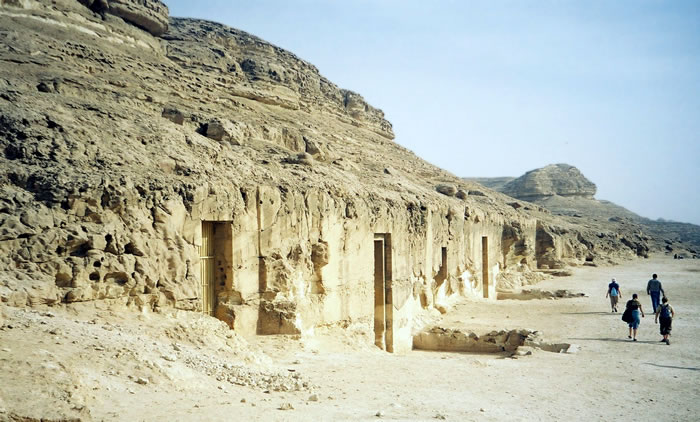
_____________________________________________________________________________________________________________
20 February 1983
Return to Cairo
I must have spent my final week and a half in Cairo.
In contrast to the traveling adventures of the previous few weeks, this was a time of reflection and friends. I wondered about my future. Is God calling me to live overseas? Or should I continue on my course toward grad studies in intertestamental history? I spent time with my friends: Bob, Maha, Rowi. I visited All Souls Church and talked with Derek Eaton. Reading my journal I can see this was an emotionally intense time.
28 February 1983
Return to Israel
Back across the desert, crossed the border at Rafiah, back through Gaza, to Tel Aviv and then home to Haifa.
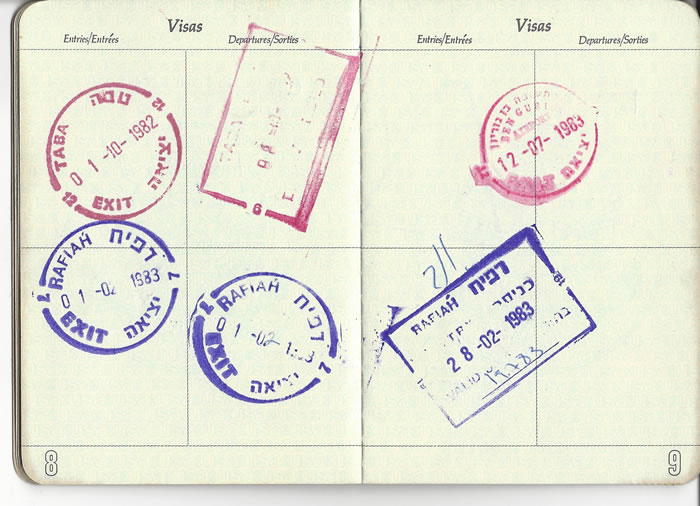
________________________________________________________________